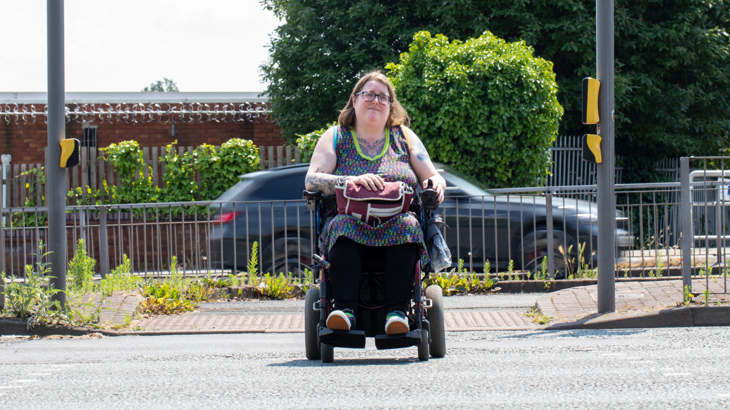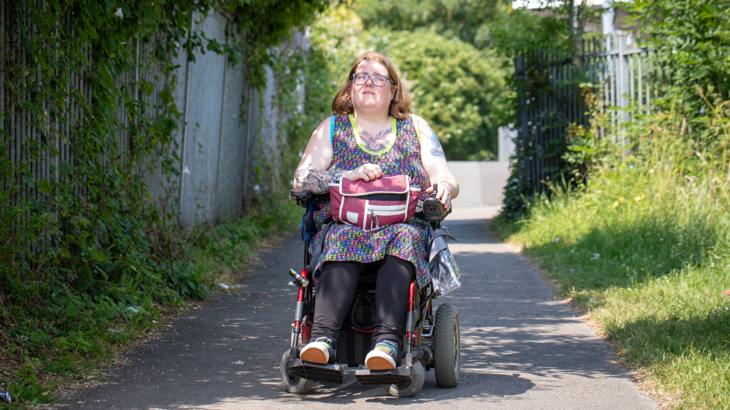Our latest Walking and Cycling Index for the Liverpool City Region shows that 78% of local residents think better pavement accessibility, like level surfaces and dropped kerbs at crossing points would help them walk or wheel more. In this blog, Snoof, who uses a powered wheelchair, describes the daily frustrations and dangers of using pavements in their East Liverpool neighbourhood. The artist and maker also talks about how the positive changes to physical barriers on their local traffic-free path are helping them to access nature and improve their wellbeing.

Credit: Chris Foster
“I mostly travel by bus for the school run, my work, and social events.
“The city centre is well-paved for the most part but when you come out a bit it’s a different story.
“People park on the pavements so I have to choose between damage to the car and my wheelchair, or risking my life in the road.
“There’s a lack of dropped kerbs too. I can get on one side of the pavement near my house but I can’t get off it. When I visited my friend his neighbour had to lift me on to the pavement.”
Snoof, who lives in Liverpool, recently damaged their powered wheelchair going over a kerb because they couldn’t see the drop down.
The frame of the chair cracked in several places and cost £600 to repair.
This incident has made them feel more nervous and fearful of wheeling anywhere independently. They said:
“It’s a ridiculous amount of extra work figuring out how you can get anywhere.
“That’s a lot of extra energy and emotional investment just to do something.
“It makes me feel excluded and feel that this city isn’t for me.
“The city is built for cars but people aren’t cars. It should be designed for people.
“If you don’t make it doable for people to use public transport, walk, cycle, use a skateboard then it’s no point arguing they should use their cars less.”
Data from our latest Walking and Cycling Index for the Liverpool City Region shows that 65% of residents support banning vehicles parking on the pavement.

Credit: Chris Foster
The positive impact of barrier removal
A few months ago, Snoof noticed that an access point on their local section of the National Cycle Network, the Liverpool Loopline had been widened.
It’s one of ten barriers that have been removed on the Loop Line as part of our Paths for Everyone programme, funded by the Department for Transport.
The route has also been resurfaced and the gradient improved to enable wheelchair users to navigate the path.
Snoof is now able to use the Loop Line more easily for short shopping trips, or accompanying their son to school.
The importance of having access to nature
Their journey on their local Network route is a little longer than going by road, but they can enjoy fresh air and nature in an urban area.
The changes to their local path are particularly welcome as Snoof has autism and ADHD - so having access to peaceful, natural places is particularly important to them. They added:
“The Loop line is really good for mental health. It’s a place where you can spend quiet time with people you want to chat to and it’s a great place to interact with nature.
“The new access point is wonderful. It was very narrow that way before and I couldn’t get past.
"Now there’s plenty of room to get through. It’s smooth and graded appropriately.
There’s still a lot more to be done to fix the rest of the Loop Line, which is part of the Trans Pennine Trail, and to improve on-road and pavement connections. But it’s a positive step in the right direction.
“It will be great to fix the Loop Line in general to make it accessible.
“It will help disabled adults and kids enjoy more independence to get out more on their own, enjoy nature, and to access services along the path, such the hospital, schools or the library.
“Having that is incredibly good for anyone.”
Snoof talks about how improvements to the Liverpool Loop Line have positively impacted the way she travels. Credit: Sustrans
Residents want more investment in active travel and public transport
Every day, walking, wheeling and cycling in Liverpool City Region take up to 340,000 cars off the road.
A majority of residents (61%) would like to see more government spending in their local area on walking and wheeling.
With 76% wanting more government spending to be invested in public transport.
The latest Walking and Cycling Index
The Walking and Cycling Index 2023 is the clearest picture of what people really think about walking, wheeling and cycling across the UK and Ireland.
It includes an independent and representative survey by NatCen of 18 cities and city regions, consisting of 21,000 residents.
Read more stories like Snoof’s in our latest Walking and Cycling Index report.
Find out how wheeling has introduced Joanne to a new community.
Note to reader
We recognise that some people who use wheeled mobility aids, for example a wheelchair or a mobility scooter, may not identify with the term walking and may prefer to use the term wheeling.
We use the terms walking and wheeling together to ensure we are as inclusive as possible.





